|
Samwell RUGGEDBOOK Rugged Tablet PC-760
Sleek, rugged Intel Bay Trail-powered 10.1-inch Windows procap tablet for advanced data capture and point-of-sale applications
(by Conrad H. Blickenstorfer, with photography by Carol Cotton)
Samwell made a splash at the 2014 Computex show in Taipei where the company introduced a full quartet of new rugged tablets. Of the four, the RUGGEDBOOK Tablet PC-760 was the sleekest and glossiest, impressing show goers with an attractive design, advanced technology, and a slew of interesting peripherals. Despite its inherent ruggedness, the 760 is well under an inch thick and weighs remarkably little. It's a thoroughly modern device with a media tablet-like glass surface that covers the entire front of the device (except the protective bumpers). RuggedPCReview.com had a chance for some extended hands-on with this new RUGGEDBOOK and found much to like, all related in thsi detailed report.
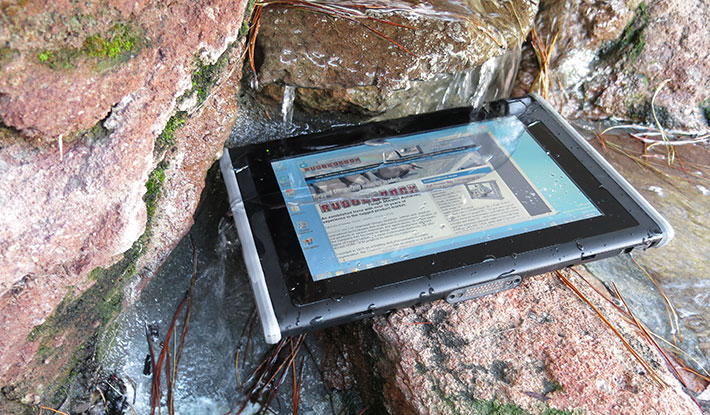
What did Samwell have in mind with the RUGGEDBOOK PC-760 and where does it fit in? That would be a variety of data capture and point-of-sale applications that require a) the ease of use of a consumer tablet, b) the durability and invulnerability of a rugged device, and c) seamless integration into Microsoft enterprise structures.
The PC-760 easily meets those requirements with an excellent capacitive multi-touch display, IP65 sealing and an impressive 4-foot drop spec (and even 6-foot with add-on bumpers!), and availability with both the full or embedded versions of either Windows 7 or Windows 8.1. Add to that NFC, GPS, industrial-grade scanning, and optional mag stripe and smart card readers, and the PC-760 looks like an interesting proposition indeed.
Taking a look at the RUGGEDBOOK PC-760
In a world of tablet computers that increasingly look more or less the same, Samwell came up with a variation of the theme that results in a unique and distinctive appearance. That's accomplished with a merging of consumer tablet design elements (such as the flush glass extending well beyond the perimeter of the actual LCD) with rugged tablet design cues (such as protruding protective border bumpers). What's different here, though, is that the protection is via what looks like gray end-caps on each side, but is actually a rigid raised band of rubberized plastic.
For size, the PC-760 measures 11.5 x 7.7 inches, and it has a 16:10 aspect ratio wide-format 10.1-inch capacitive multi-touch display. Weight is 2.65 pounds, not much at all for a rugged tablet. Onboard wired I/O is limited to USB, Micro HDMI and audio, but a handy office dock provides serial, VGA and LAN as well. There is no keypad and there are no hardware controls other than a pushbuttons for barcode scanning and the camera shutter.
The image below shows the Samwell RUGGEDBOOK PC-760 from the front and all four sides:

Visible are on top the scanner and camera buttons as well as the on/off pushbutton. On the right side are surface mount contacts for the optional magnetic stripe and smart card readers. On the bottom is the primary docking surface mount connector as well as the power jack that's protected with a hinged rubber plug.
All of the PC-760's onboard I/O is concentrated in a recessed block on the left side of the tablet. When not in use, the I/O block is protected by a solid and very cleverly designed hinged door with a pressure seal on it. Once unlocked via slide lever, the door easily flips open, in pleasant contrast to the protective doors on many rugged devices that have to be pried open with a screwdriver or fingernails.
The image below shows the left side of the PC-760 with the protective I/O block cover in the open position:

What's available onboard the tablet itself here is:
- 1 x Type D Micro HDMI (here we'd have liked to see a full-size HDMI port; micro HDMI is flimsy and too easily confused with the almost identical looking micro-USB)
- 1 x USB 2.0
- 1 x USB 3.0
- 1 x audio in/out
If that is not enough, and in a stationary deployment it likely won't be, Samwell offers an optional dock that adds another USB port as well as separate microphone and headphone jacks in the front, and power, RJ45 LAN, VGA video, and a standard DB9 serial port in the back.
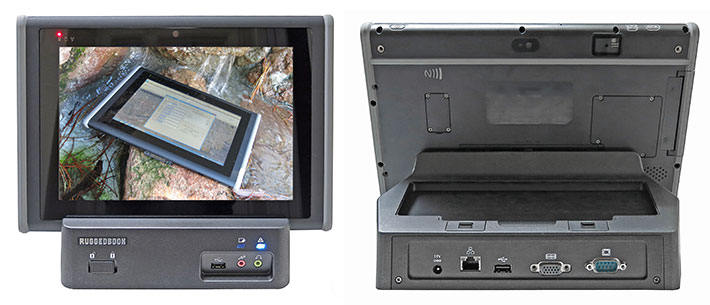
Note that the dock also doubles up as a charging station for a second battery. Also note that once in place on the dock, the tablet is secured by a friction lock lever. We'd have liked to see an actual lock for use in deployments where additional security is needed.
Design and construction
What almost always sets consumer and industrial/enterprise market devices apart is materials and construction. Whereas with consumer tablets the emphasis is on slick design that often comes at the expense of durability and serviceability, workhorse products created for the field are less glossy and not as slim, but sturdier and easier not only to work with, but also to work on.
The RUGGEDBOOK PC-760's housing consists of black plastic upper and lower halves, with a kind of protruding rubberized gray edge protection running around the entire perimeter of the left and right sides of the tablet. There are three externally accessible compartment on the tablet's backside. There's a small place for the SIM card beneath a plastic door with a pressure seal, held in place with four small Philips screws, there's a larger compartment for expansion, and there's the battery bay.

The battery compartment doesn't have a cover; the battery fits into it as part of the design (which should make it possible to have higher capacity optional batteries). The small standard battery is secured with a single small lever, and there's a slight chance that it may open by accident. The battery compartment is not sealed, but there's a pressure seal around the battery contacts to keep liquids out from the interior.
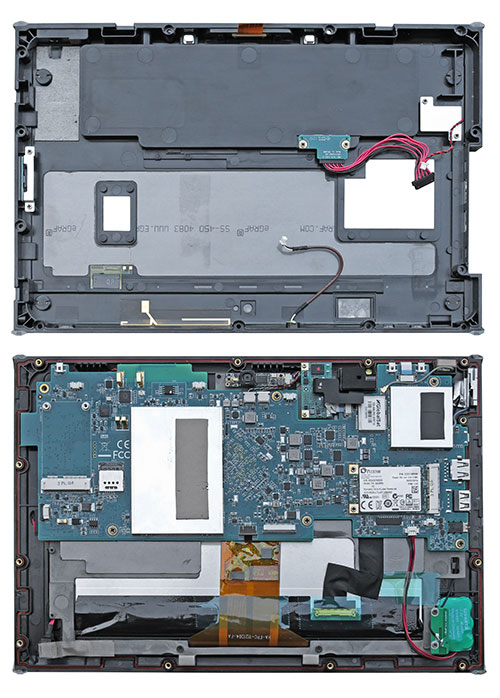 Opening the PC-760 means removing the protective door to the I/O box and then undoing 12 small and easily accessible Philips screws. Opening the PC-760 means removing the protective door to the I/O box and then undoing 12 small and easily accessible Philips screws.
As is usually the case, there are some wires and ribbon cables between the halves. Those must be carefully disconnected before flipping open the two sides.
Inside, you can then see a lightweight magnesium chassis/frame to which are attached the LCD assembly on one side and the (265 x 105 mm) main circuit board on the other. The board reveals a second mini-PCIe slot that was empty on our unit and would presumably be used for an optional WWAN module. All I/O is edge-mounted directly onto the mainboard.
As far as sealing between the two halves goes, Samwell is using a tongue-and-groove design with an orange o-ring type seal pressed into the groove. This way it is easily visible and won't get lost.
The PC760 doesn't have a fan to handle the modest heat load of its Bay Trail chip and related circuity. Instead, the company is using GrafTech International's clever heat spreader system that uses flexible graphite spreader plates. Graphite is lighter and offers better conductivity than copper or aluminum while eliminating hot spots and the need for heat pipes (see GrafTech here). It's a really interesting solution, with the flat, custom-cut graphite spreadershield taped to its specially marked area in the 760's bottom part of the housing. Note that the GrafTech heat spreader technology is also applied beneath the main board where the heat is collected and then spread evenly to the heatspreader and from there to the magnesium frame. Very clever.
There are two camera modules. One uses the SunplusIT SPCA2089A fullHD/5mp USB camera controller (see specs here) allowing for a tiny camera board that measures just 40 x 8 mm. The forward-facing 2.0 mp camera strip is of about the same size, but of unidentified origin.
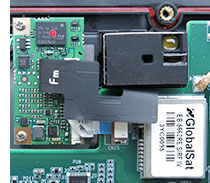 The PC760's optional 1D/2D barcode scanner was installed in our unit, and it was an Intermec ED40, consisting of the ED40 USB-based decoder board (see specs here) and an EA31 high performance 2D imager (see specs here, known for its speed, high motion tolerance, and omni-directional scanning support. Our 760 also came with the Intermec EasySet utility that provides comprehensive setup, setting, and configuration functionality for the scanner. The PC760's optional 1D/2D barcode scanner was installed in our unit, and it was an Intermec ED40, consisting of the ED40 USB-based decoder board (see specs here) and an EA31 high performance 2D imager (see specs here, known for its speed, high motion tolerance, and omni-directional scanning support. Our 760 also came with the Intermec EasySet utility that provides comprehensive setup, setting, and configuration functionality for the scanner.
The presence of this high-quality, industrial-grade Intermec scanner/decoder is another sign that the PC-760 is a serious tool for the job. Lesser tablets may simply use their onboard camera for scanning, but Samwell didn't cut any corners here.
Also visible is in the detail picture to the right is the unit's GlobalSat SiRF IV-based GPS module (see specs here) that offers very fast time to first signal, very high sensitivity, predicts satellite positions for days ahead, and uses very little power even when remaining in hot-start position.
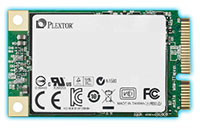 There's a somewhat larger compartment with access to a single full-size PCI-e connector, taken up in our eval unit by a Plextor PX-64G5Me mSata industrial solid state disk (see here). The PX-64G5Me is capable of 530 MB/s sequential reads and 150 MB/s sequential writes, has a mean time between failures of 1.5 million hours, and can handle 50,000 power on/off cycles. A good choice. There's a somewhat larger compartment with access to a single full-size PCI-e connector, taken up in our eval unit by a Plextor PX-64G5Me mSata industrial solid state disk (see here). The PX-64G5Me is capable of 530 MB/s sequential reads and 150 MB/s sequential writes, has a mean time between failures of 1.5 million hours, and can handle 50,000 power on/off cycles. A good choice.
The compartment's protective plastic cover also has a pressure seal and is secured by four small Philips screws. This design means that while mass storage is secure and requires a screw driver to get to, the SSD can also easily be removed, which may be a requirement in certain deployments.
Also present is an EETI EX5920-based projected capacitive touch screen controller (see here).
Overall, this is a clean, straightforward, nicely executed design that also provides easy access for configuration, maintenance and repair.
Powered by Intel Bay Trail
Samwell has always had a knack of finding just the right processor for the various members of its lineup of RUGGEDBOOKs and, though Intel is offering a more bewildering variety of processors and processor families than ever, that hasn't changed. Each RUGGEDBOOK is equipped with a different chip, selected as the best solution for the product's intended application. With the PC-760,  Samwell was aiming for enough computing and graphics performance to handle the intended mobile point-of-sale and data capture tasks without a noisy fan and without breaking the bank, and so they chose the Intel Celeron N2930. Samwell was aiming for enough computing and graphics performance to handle the intended mobile point-of-sale and data capture tasks without a noisy fan and without breaking the bank, and so they chose the Intel Celeron N2930.
The N2930 is part of Intel's still new "Bay Trail" platform which uses state-of-the-art 22nm process technology. Bay Trail is based on Intel Atom, and not Core, processor technology, but represents the first major advance in Atom microprocessor architecture since the platform arrived several years ago. Unlike the fairly narrow focus of earlier Atom product generations, "Bay Trail" consists of a large family of single, dual, and quad core processor chips optimized for a broad range of devices. In another departure from earlier naming practice, not all Bay Trail processors use Intel's "Atom" brand; the more powerful versions targeting notebooks, tablets and desktops are sold as Celerons — such as the N2930 used in the PC-760 — and even Pentiums.
In another departure, Bay Trail marks the first time that the Intel Atom microprocessor architecture includes Intel's own graphics. The graphics cores integrated into Bay Trail systems are of the same HD 4000 architecture and variety as those used in Intel's 3rd generation "Ivy Bridge" processors, albeit with fewer execution units (four instead of several times that number) and lower clock speeds. Still, the new graphics support most of the same APIs and features, including DirectX 11, OpenGL 4.0, OpenCL 1.2, and the chips can inherently support dual displays up to 2560 × 1440 (or 1080p over HDMI). Better yet, there's also turbo boost in some processors, including the N2930. It's called "Burst Speed" in Bay Trail, and the handy power-saving "active idle" feature from Haswell core processors is there as well, helping systems very quickly wake up from a power-conserving state.
Performance
Intel initially conceived the Atom processor as an inexpensive platform that drew very little power. It succeeded at that, but performance wasn't anywhere near the Core processor level, and many early Atom-based products offered barely acceptable speed. That's probably why Intel is now using the Celeron and Pentium brand names for higher-end Bay Trail processors. Those brand names, of course, also have their connotations (and not always good ones), and that's why many companies, including Samwell, simply refer to them as "Bay Trail."
To see what the 1.83GHz quad-core Bay Trail N2930 can do in the RUGGEDBOOK PC-760, we used Passmark Software's PerformanceTest 6.1 that runs about 30 tests covering CPU, 2D graphics, 3D graphics, memory, and disk and then computes scores for each category and an overall PassMark score. We also ran our secondary standard benchmark suit, CrystalMark. For comparison, we're listing our benchmark results for a variety of other 10-inch class tablets RuggedPCReview has recently tested. This lineup is particularly interesting as each product is based on a different low power Intel chip using Atom architecture. The results are as follows:
|
Samwell RUGGEDBOOK PC-760 Benchmarks and Comparisons
|
|
PERFORMANCE COMPARISON
|
RUGGEDBOOK
|
GammaTech
|
Handheld Group
|
RUGGEDBOOK
|
Winmate
|
Xplore
|
|
Model
|
PC-760
|
CA10
|
Algiz 10X
|
PC751
|
101B
|
Bobcat
|
|
Processor Type
|
Intel Celeron
|
Intel Atom
|
Intel Atom
|
Intel Atom
|
Intel Celeron
|
Intel Atom
|
|
Processor Type: Intel
|
N2930
|
N2600
|
N2800
|
E3825
|
N2920
|
E3845
|
|
Code name
|
Bay Trail
|
Cedarview
|
Cedarview
|
Bay Trail
|
Bay Trail
|
Bay Trail
|
|
Thermal Design Power (TDP)
|
7.5 watts
|
3.5 watts
|
6.5 watts
|
6.0 watts
|
7.5 watts
|
10.0 watts
|
|
CPU Clock
|
1.83GHz
|
1.60GHz
|
1.86GHz
|
1.33GHz
|
1.86GHz
|
1.91GHz
|
|
CPU Cores/Threads
|
4/4
|
2/4
|
2/4
|
2/2
|
4/4
|
4/4
|
|
Graphics
|
Intel HD
|
PowerVR
|
PowerVR
|
Intel HD
|
Intel HD
|
Intel HD
|
|
CPU Mark
|
2,177.9
|
463.2
|
538.4
|
572.2
|
1,998.8
|
1,924.9
|
|
2D Graphics Mark
|
190.0
|
NA
|
38.8
|
84.4
|
147.0
|
149.2
|
|
Memory Mark
|
456.4
|
205.6
|
264.2
|
238.3
|
396.3
|
397.1
|
|
Disk Mark
|
2,087.3
|
1,127.7
|
1,732.8
|
379.7
|
2,045.1
|
2,513.9
|
|
3D Graphics Mark
|
142.8
|
65.9
|
80.3
|
91.2
|
121.5
|
158.1
|
|
Overall PassMark
|
1,131.4
|
395.5
|
554.5
|
296.1
|
1,055.4
|
1,133.8
|
|
ALU
|
29,849
|
10,673
|
12,191
|
9,158
|
26,407
|
25,808
|
|
FPU
|
24,086
|
8,073
|
9,374
|
7,504
|
22,883
|
21,815
|
|
MEM
|
20,136
|
7,099
|
8,654
|
12,170
|
18,836
|
25,613
|
|
HDD
|
32,309
|
21,856
|
27,789
|
13,828
|
36,656
|
36,177
|
|
GDI
|
6,001
|
1,372
|
1,683
|
2,991
|
4,680
|
4,931
|
|
D2D
|
3,915
|
532
|
689
|
2,472
|
3,581
|
3,616
|
|
OGL
|
3,698
|
7,114
|
8,641
|
2,050
|
3,331
|
3,305
|
|
Overall CrystalMark
|
119,994
|
56,719
|
69,221
|
50,173
|
116,374
|
121,265
|
The benchmarks here primarily show two things. First, that Intel's "Bay Trail" platform indeed marks a big step forward compared to the prior Intel "Cedarview" chips (which themselves were a big step ahead of earlier Atom processors). And second, the results also show that quad-core configurations really can make a large performance difference compared to dual-core designs.
 Overall — and we've found that to be true in other quad-core Bay Trail-based tablet products — the RUGGEDBOOK PC-760 provides provides roughly twice the performance of tablets based on the popular Intel Atom N2600 processor, and probably more. Overall — and we've found that to be true in other quad-core Bay Trail-based tablet products — the RUGGEDBOOK PC-760 provides provides roughly twice the performance of tablets based on the popular Intel Atom N2600 processor, and probably more.
And consulting RuggedPCReview's performance benchmark database, the PC-760 is also quicker than many early Intel Core and even 2nd generation Core-based products used to be. That's impressive, especially since it's achieved without a fan.
Whenever we present performance benchmark results we caution to not only look at the processor performance, but also at the performance of the other sub-systems. There is one hardware area in particular that can have a great impact on overall system performance, and that's mass storage. In virtually every Atom system benchmark we've ever run, solid state disks beat rotating media by a large margin. And there can also be large benchmark performance differences between different types of SSDs. Here, Samwell chose wisely, as the PC-760's Plextor mSata industrial solid state disk is an excellent performer.
In everyday real-life usage, the RUGGEDBOOK PC-760 feels very quick and very responsive, certainly more than enough for its intended jobs.
Power consumption
As stated above, when Intel Atom processors first hit the market a few years ago, their two primary selling points were low cost and minuscule power consumption compared to high-end processors of the day. In the meantime, Atom thermal design power has been creeping upward, whereas Intel's Core processors have become ever more power-efficient. We now routinely see Intel Core-powered mobile devices that have lower minimal power draws than that of Atom-based devices. Where does the N2930-powered 760 stand in terms of power draw?
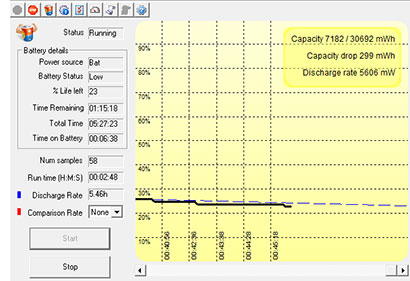 We used Passmark Software's BatteryMon power management benchmark utility to measure the 760's power draw under various operating conditions. We used Passmark Software's BatteryMon power management benchmark utility to measure the 760's power draw under various operating conditions.
With the Windows power options set to "Power Saver" and display brightness set to minimum, we saw an idle power draw of 5.6 watts. With backlight normal (about 1/3rd of capacity) it was 6.0 watts, and with display brightness set to maximum, it rose to 7.3 watts.
With the Windows power options set to "Balanced" and display brightness set to minimum, we saw an idle power draw of 6.2 watts. With backlight normal, it was 6.7 watts, With display brightness set to maximum, it rose to 8.0 watts.
With the Windows power options set to "High Performance" and display brightness set to minimum, we saw an idle power draw of 6.5 watts. With backlight normal, we saw 6.9 watts, and with display brightness set to maximum, it rose to 8.4 watts.
This means that at least when idling along, the Windows power settings have minimal impact on the PC-760's battery life.
We then placed a full load on the processor by running 1080p HD video in High Performance mode and with the backlight set to maximum. Amazingly, we still only saw 8.4 watts, which means the chip isn't working hard at all when decoding video.
According to BatteryMon, the design capacity of the PC-760's Li-Ion battery was 31 watt-hours (11.1V, 2,900 mAH). That would indicate a maximum battery life of about 5.5 hours without the system going to sleep. If the PC-760 were designed primarily for carry-around mobile field use, we would have liked a higher capacity battery. But given the device's mobile POS focus where it'll likely spend much of its time docked, the battery is adequate.
Two integrated cameras
The PC-760 has two integrated cameras. The user-facing one is centered above the LCD, the rear-facing one is in exactly the same spot as the frontal camera, only facing the other way. Both cameras can record stills and video, and as USB devices, both are accessible via other imaging applications. Our evaluation unit came with Windows 8.1 Embedded and did not appear to have a camera app installed and so we couldn't do testing. The camera was available, though, for taking the picture to go with the user login.

As is, 2mp and 5mp resolution isn't much in this day and age of super-high resolution cameras in most consumer smartphones and tablets. Both cameras, however, can record in both 720p and 1080p video. Autofocus was a bit slow at times, but both cameras, in a pinch, are good enough for rough project documentation images and video. But we would not rely on them for important details.
Bright, vibrant 10.1-inch display
The LCD industry long ago mastered the art of creating sharp, bright displays that provide a thoroughly satisfying indoor viewing experience. In time the display industry also came up with screens that had near-perfect viewing angles from all direction, and these have pretty much become the norm. One problem, though, remains, and that is providing a satisfactory viewing experience outdoors where no backlight is a match for the sun, and where harsh reflections make most displays difficult to read. Makers of computing gear meant to be used outdoors have been addressing the problems with various degrees of success. How did Samwell do with the PC-760, both in general and in outdoor use?
Quite well. The PC-760's 10.1-inch display is large enough to use Windows comfortably, and its 1280 x 800 pixel resolution means about 150 dpi (dots per inch) and makes it plenty sharp enough for virtually any application. 150 dpi, while not in the "retina" class of super-high res screens, is more than the original iPad and much more than the Apple iMac27 I am writing this review on. But what about outdoor viewing?
Samwell documentation doesn't usually specify what type of LCD they are using in a device, or who makes it. The RUGGEDBOOK website does have a page where they explain their sunlight display technology (see here). It is pretty much the same approach used by most other rugged notebook and tablet makers, i.e. various means to minimize internal reflection so that the screen's backlight exceeds the amount of reflected light by as much as possible. That's done by minimizing the number of reflective surfaces in the many layers of a typical LCD assembly via bonding layers together and via polarizers and anti-reflective and anti-glare coatings.
Assuming that Samwell employed all those measures in the PC-760 screen, how well does it work? Quite well. The pictures below show the PC-760 side by side with a 3rd generation Apple iPad we have in our lab and often use as a benchmark. The iPad has a very good display and it's being used by tens or hundreds of millions outdoors every day. The iPad screen surface is glossy and, unlike that of some of Samwell's other tablets, so is the PC-760's.
The first picture below shows the two tablets in bright sunshine outdoors in a semi-shaded area with plenty of contrasts. Both screes have their brightness cranked up to the max. What's instantly obvious is the reflections on the glass-like surfaces of both tablets. The glossy bezels of both reflect as well. We've long wondered why glossy screens are so popular, but they are. Hundreds of millions of tablets are glossy and they are successful. So we won't hold the glossiness against the PC-760.

The good news, though, is that if you look at the tablets from a position that precludes annoying reflections, the displays are perfectly readable even outdoors. Sure, this is not in direct sunlight, but it's amazing how nice and bright the PC-760 remains.
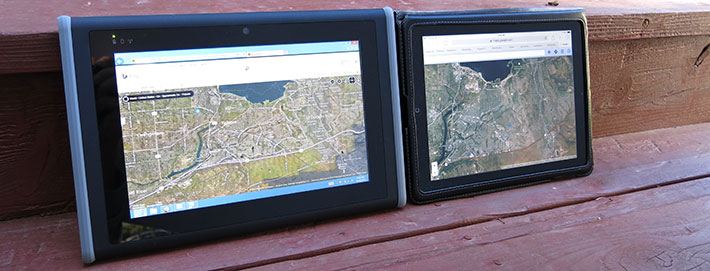
The picture below does reveal a small weakness of the PC-760 display: when looked at from certain angles, the picture becomes noticeably more muted. There isn't the dreaded color shift that appears on some lesser displays, but the image does sort of fade a bit.

The final picture here has both tablets face the open sky. Even without direct sunlight that means strong ambient light. Both tablets remain readable to an extent, which is something that wouldn't have been possible just a few years ago. The Samwell tablet doesn't do better than our 3rd gen iPad but, again, that means it's remarkably good. Millions use iPads outdoors every day, and being as good as an iPad is significant praise.

Overall, while we're seeing a fairly rapid move in the direction of higher resolution displays in tablets, the PC-760's 1280 x 800 is absolutely fine for its intended tasks. The display is bright, sharp, and very readable. And it can be used outdoors.
Digitizer: capacitive multi-touch
Up to perhaps a couple of years ago, the vast majority of all industrial tablets used either resistive touch for use with a finger or a passive stylus, or they had an active digitizer with a special pen, usually of the Wacom variety that doesn't need a battery. Often the two methods were combined with either manual or automatic switching from one to the other. That tried-and-true approach changed when first the iPhone and then the iPad came along and convincingly demonstrated the appeal of capacitive multi-touch with its effortless panning and pinching and zooming. As a result, more and more vertical market tablets, including the RUGGEDBOOK PC-760, are now using capacitive multi-touch.
With Microsoft Windows, capacitive touch can be a mixed blessing. It works well, of course, with the new and totally touch-oriented "Metro" interface of Windows 8.1, but not nearly as well with the version's legacy desktop, or with Windows 7 with all of its small check boxes and narrow scrollers that were clearly designed for use with a mouse. This can, in part, be addressed by optimizing the legacy Windows user interface in Windows 7 (see RuggedPCReview's how-to) or in Windows 8.1 via the Registry Editor (see here).
Another issue with capacitive touch is that it generally doesn't work with gloves on. That may not be an issue with the PC-760's intended POS applications, but it's something to keep in mind.
Remarkable ruggedness
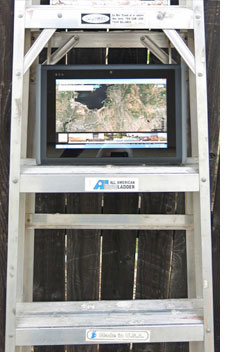 As the brand name implies, Samwell is in the business of making rugged computing technology. They consider the RUGGEDBOOK PC-760 a fully rugged device. Its plastic housing is quite sturdy, and the design's toughness is enhanced by the sturdy raised rubberized plastic endcaps on both sides of the tablet. This makes the device significantly less prone to serious damage, or even scratching, should it fall or get banged around. As the brand name implies, Samwell is in the business of making rugged computing technology. They consider the RUGGEDBOOK PC-760 a fully rugged device. Its plastic housing is quite sturdy, and the design's toughness is enhanced by the sturdy raised rubberized plastic endcaps on both sides of the tablet. This makes the device significantly less prone to serious damage, or even scratching, should it fall or get banged around.
Samwell generally performs a variety of MIL-STD-810G testing, both in their inhouse lab and through external 3rd party testing labs. The PC-760 carries an impressive 4-foot drop spec which indicates that it passed the MIL-STD 810G Method 516.6 Procedure VI "Drop" test that includes 26 drops to concrete on each face, edge and corner from 48 inches. Samwell's specs say that the tablet can even handle 6-foot drops with optionally available thicker rubber bumpers. The documentation does not indicate whether the device also passed mechanical shock, random vibration, temperature/humidity cycling as well as high/low temperature tests.
As far as sealing against the elements goes, the PC-760 carries an IP65 ingress protection rating where the "6" means the unit is totally protected against dust, and the "5" means the machine is protected against low pressure water jets from all directions, although limited ingress is permitted. IP65 is more than respectable for a design meant primarily for POS and similar applications, and the drop spec, likewise, is absolutely up to the job. The standard operating temperature range is a wide 14 to 122 degrees Fahrenheit (-10 to 50 degrees centigrade). That's wide enough to allow deployment in most settings.

The pictures below show some of the typical independent ruggedness testing Samwell commissions to have performed on their units.

Summary
The Samwell RUGGEDBOOK PC-760 provides Windows 7 or Windows 8.1 functionality either in their full or embedded versions, and it does so in a refreshingly unique rugged tablet form factor. Measuring 11.5 x 7.7 x 0.8 inches and weighing well under three pounds, the PC-760 is slim and handy compared to traditional full-size rugged tablets. Its sharp and bright 10.1-inch touch screen with 1280 x 800 pixel resolution offers enough space to run Windows comfortably. Capacitive multi-touch provides the kind of effortless ease of operation expected today by users spoiled by their smartphones and consumer tablets.
The tablet offers a wealth of advanced wireless functionality (802.11ac WiFi, Bluetooth 4.0, NFC RFID, GPS, and 3G or 4G WWAN). Wired I/O is limited to USB and micro-HDMI, but more is available from the well-designed optional dock (Ethernet, USB, VGA, RS232 serial, audio). The integrated 2-megapixel and 5-megapixel cameras are workable.
 Powered by a quad-core 1.83GHz Intel "Bay Trail" N2930 processor, the PC-760 provides surprisingly brisk performance and also acceptably long life from the smallish battery. And thanks to the low Thermal Design Power of the processor and very clever thermal design, it does so without the need of a fan. Powered by a quad-core 1.83GHz Intel "Bay Trail" N2930 processor, the PC-760 provides surprisingly brisk performance and also acceptably long life from the smallish battery. And thanks to the low Thermal Design Power of the processor and very clever thermal design, it does so without the need of a fan.
Designed for mobile point-of-sale and data collection tasks, the PC-760 includes industrial-grade components (such as a dedicated Intermec EA31 1D/2D scanner and ED40 decoder) to get the job done quickly and reliably. Available options include bolt-on magnetic card and Smart Card readers, as well as HF RFID.
The PC-760, which has a magnesium chassis, feels solid and well-made, and the unique rubberized raised end-caps helps it fend off damage in the field. The device is also very well-sealed and remarkably resistant to drops.
With the RUGGEDBOOK PC-760, Samwell offers a rugged, speedy, unique and thoroughly modern Windows tablet designed primarily for mobile POS and scanning, but suitable for a wide range of applications.
-- Conrad H. Blickenstorfer, November 2014
Samwell RUGGEDBOOK PC-760 Specs:
| Status |
Added 05/2014, full review 11/2014
|
| Type |
Rugged Windows Tablet PC
|
| Processor type |
Quad-core Intel Atom N2930 |
| Processor speed |
1.83GHz (2.16GHz burst speed)
|
| Chipset |
Intel integrated
|
| Graphics |
Intel HD Graphics
|
| CPU Thermal Design Power |
7.5 watts |
| OS |
Microsoft Windows 7 or Windows 8.1, both Pro or Embedded |
| Memory |
up to 8GB DDR3L-1333MHz SO-DIMM
|
| Display |
10.1-inch/WXGA (1280 x 800 pixel) TFT with LED backlight; optional sunlight readable display with 800 nits |
| Digitizer |
Projected capacitive touch |
| Keyboard |
Onscreen keyboard |
| Navigation |
Stylus, touch |
| Storage |
up to 128GB SSD
|
| Expansion slots |
1 x SIM card |
| Housing |
Unknown |
| Size |
11.5" x 7.7" x 0.78" (292mm x 196mm x 20mm) w/o bumpers |
| Weight |
1.2kg (2.65 pounds) as tested w/ battery |
| Operating temperature |
14° to 122°F (-10° to 50°C)
|
| Temperature/humidity |
Est: MIL-STD-810G, Method 507.5, Procedure II (10-95%) |
| Ingress protection |
IP65 |
| Altitude |
Est: MIL-STD-810G, Method 500.5, Procedures I & II |
| Drop/shock (with SSD) |
MIL-STD-810G, 514.6, 26 x 4 feet drop (6 feet with add-on bumpers) |
| Shock (with SSD) |
Est: MIL-STD-810G, Method 516.6, Procedure I , 40g, 11ms operation
|
| Salt Fog |
NA |
| Vibration |
Est: MIL-STD-810G, Method 514.6, Procedures I & II |
| Power |
"5hrs standard battery, 8hrs extended battery"
|
| Cameras |
Rear: 5-megapixel AF with LED flash, front: 2-megapixel webcam |
| Sensors |
G-sensor, ambient light, E-compass |
| Interface |
1 x USB 3.0, 1 x USB 2.0, 1 x micro-HDMI, expansion, docking, audio in/out |
| Wireless options |
802.11ac WiFi, Bluetooth 4.0, NFC RFID; optional 1D/2D barcode scanner, expansion for mag stripe reader and SmartCard, 3G or 4G LTE WWAN, HF RFID, GPS
|
| Price |
Inquire |
| Contact |
Samwell Group |
| Product page |
Samwell RUGGEDBOOK PC-760 product page |
| Brochure |
 RUGGEDBOOK 760 brochure (PDF) RUGGEDBOOK 760 brochure (PDF) |
| Contact |
Samwell
317-1, Sec. 2, An Kang Rd.,
Hsintien Dist., New Taipei City
Taiwan, R.O.C. |
(copyright 2014 RuggedPCReview.com)
|



